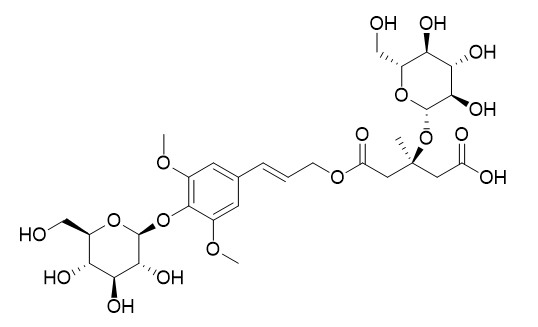Tangshenoside I
Tangshenoside I might be a potential bioactive marker related to the hematopoietic and immunologic functions of Codonopsis Radix, which could be recommended as the index compound. It has α-glucosidase inhibition activity.
Inquire / Order:
manager@chemfaces.com
Technical Inquiries:
service@chemfaces.com
Tel:
+86-27-84237783
Fax:
+86-27-84254680
Address:
1 Building, No. 83, CheCheng Rd., Wuhan Economic and Technological Development Zone, Wuhan, Hubei 430056, PRC
Providing storage is as stated on the product vial and the vial is kept tightly sealed, the product can be stored for up to
24 months(2-8C).
Wherever possible, you should prepare and use solutions on the same day. However, if you need to make up stock solutions in advance, we recommend that you store the solution as aliquots in tightly sealed vials at -20C. Generally, these will be useable for up to two weeks. Before use, and prior to opening the vial we recommend that you allow your product to equilibrate to room temperature for at least 1 hour.
Need more advice on solubility, usage and handling? Please email to: service@chemfaces.com
The packaging of the product may have turned upside down during transportation, resulting in the natural compounds adhering to the neck or cap of the vial. take the vial out of its packaging and gently shake to let the compounds fall to the bottom of the vial. for liquid products, centrifuge at 200-500 RPM to gather the liquid at the bottom of the vial. try to avoid loss or contamination during handling.
Journal of Medicinal Food2023, Vol.26(10).
Sci Rep.2016, 6:25094
Nutrients.2023, 15(4):950.
ACS Omega.2022, 7(44):40009-40020.
J of the Society of Cosmetic Scientists of Korea2018, 44(4):407-417
Evid Based Complement Alternat Med.2021, 8707280.
Fitoterapia.2021, 153:104995.
University of Central Lancashire2017, 20472
Cancers (Basel).2023, 15(1):37.
Food Control2022, 132:108434.
Related and Featured Products
J Ethnopharmacol. 2019 May 23;236:31-41.
Exploring on the bioactive markers of Codonopsis Radix by correlation analysis between chemical constituents and pharmacological effects.[Pubmed:
30776470]
Codonopsis Radix is a commonly used traditional Chinese medicine, and has the effect of strengthening spleen and tonifying lung, nourishing blood and engendering liquid. In addition, it is also used as important food materials.
The aim of the study was to explain the underlying correlations between chemical constituents and pharmacological effects and explore the bioactive markers of Codonopsis Radix.
METHODS AND RESULTS:
Codonopsis Radix samples from Min county, Gansu province processed with different methods were taken as the materials, UPLC-ESI-Q-TOF-MS/MS analysis was conducted to identify the compounds and establish UPLC fingerprint. Meanwhile, hematopoietic and immunologic functions of Codonopsis Radix were investigated to obtain relevant pharmacological index. Then, the correlation analysis between chemical constituents in UPLC fingerprints and pharmacological effects was carried out. The plant name was confirmed to the database "The Plant List" (www.theplantlist.org).
According to the results of canonical correlation analysis, tryptophan, syringin, Tangshenoside I, codonopyrrolidium A, lobetyolin and two unknown compounds might be the potential bioactive markers related to the hematopoietic and immunologic functions of Codonopsis Radix, which could be recommended as the index compounds.
CONCLUSIONS:
This study illustrated the underlying correlations between chemical constituents and pharmacological effects, explored the pharmacological material basis, and could lay a foundation for the improvement of quality standard of Codonopsis Radix.
Agricultural Chemistry & Biotechnology, 2006, 49(4):162-164.
α-Glucosidase Inhibitors from the Roots of Codonopsis lanceolata Trautv.[Reference:
WebLink]
Codonopsis lanceolata Trautv. is a plant of the Campanulaceae family, which is distributed throughout Korea, Japan and China. C. lanceolata has been cultivated and its roots have been used as food especially in Korea. Other Codonopsis species, C. pilosula and C. tangshen were used as medicine (Tang-Sam) for ulcers, memory improvement and immunostimulating; however, C. lanceolata was treated as an adulterant in Japan and China.1,2).
METHODS AND RESULTS:
Several studies of the chemical constituents of C. pilosula, C. tangshen and C. ussuriensis have been reported in the literatures.3-6) There are some reports on secondary metabolites of C. lanceolata; on the isolation of triterpenoid, saponin and alkaloid from the roots7-10) and the isolation of flavonoids from the leaves.11).
CONCLUSIONS:
The present report deals with the isolation, structure determination and α-glucosidase inhibition activity of Tangshenoside I and adeonsine from the roots of C. lanceolata.



